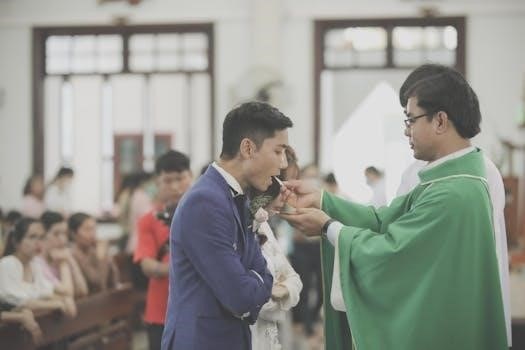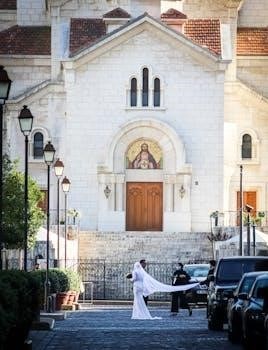The Catholic rite of marriage is a sacred ceremony‚ rich in symbolism and tradition. It emphasizes the couple’s free consent and God’s blessing on their union. It is not just a social event; it is a sacrament.

Overview of the Catholic Wedding Ceremony
The Catholic wedding ceremony typically begins with an entrance procession‚ often accompanied by music or an entrance song. This is followed by the Liturgy of the Word‚ including readings from scripture and a homily by the priest‚ which expounds the meaning of Christian marriage. Then‚ the Rite of Marriage itself takes place‚ featuring the exchange of vows and rings. If the wedding is celebrated within Mass‚ the Liturgy of the Eucharist follows. The ceremony concludes with the nuptial blessing and a final procession. The liturgy is designed to be meaningful and engaging for all‚ including non-Catholics‚ though some may find certain parts unfamiliar. The ceremony emphasizes the couple’s consent and commitment before God and the community.

Key Elements of the Rite
The core of the Catholic marriage rite includes the vows‚ questions of consent‚ and the blessing of rings. These elements emphasize the couple’s commitment and God’s grace in their union. Each is essential.
The Marriage Vows
The marriage vows are central to the Catholic wedding ceremony‚ representing the heart of the couple’s commitment. These vows are exchanged after the questions of consent and before the blessing and giving of the rings. They serve as a rich reflection‚ not only for those entering marriage but also for those who have been married for years‚ offering a chance to revisit their initial promises. The vows are a public declaration of the couple’s intention to enter into a lifelong covenant‚ mirroring Christ’s love for the Church. They signify a profound commitment to love‚ honor‚ and cherish each other through all of life’s experiences. These words carry significant weight within the Catholic understanding of marriage‚ emphasizing the sacredness and permanence of the union. The vows are not mere words‚ but a solemn promise made before God and the community.
Questions Before Consent
Prior to the exchange of vows‚ the Catholic rite of marriage includes specific questions posed to the couple‚ ensuring their freedom and understanding of the commitment they are about to make. These questions are crucial‚ emphasizing that marriage is a voluntary act‚ not an arranged one. The questions address the couple’s understanding of the nature of marriage‚ highlighting its permanence and fidelity. They are designed to establish that each individual enters into the union without coercion‚ fully aware of the responsibilities and expectations that come with marriage. This step in the ceremony underscores the Church’s view that marriage is a sacred covenant‚ requiring a deliberate and informed decision from both partners. The responses given affirm the couple’s willingness to embrace the lifelong commitment they are undertaking.
Blessing and Giving of Rings
Following the exchange of vows‚ the blessing and giving of rings is a significant part of the Catholic wedding ceremony. The priest blesses the rings with holy water‚ invoking God’s grace upon them. These rings‚ now consecrated‚ become outward symbols of the couple’s unending love and fidelity to one another. The groom then places the ring on the bride’s finger‚ reciting a pledge of love and faithfulness‚ often including the Trinitarian invocation. Subsequently‚ the bride places a ring on the groom’s finger‚ repeating a similar vow. This act signifies the mutual commitment and the binding of their lives together in a sacred union. The rings serve as a tangible reminder of the vows they have taken and the love they share.

Specific Liturgical Aspects
The Catholic rite of marriage has specific liturgical considerations‚ including whether it is celebrated within or outside of Mass. These options offer variations in the ceremony’s structure and flow‚ impacting the overall experience.
Celebration of Marriage During Mass
When a Catholic marriage is celebrated during Mass‚ it is typically a more solemn and elaborate affair. The wedding ceremony is incorporated into the Eucharistic liturgy‚ emphasizing the spiritual significance of the union; White vestments are worn‚ and the wedding Mass is used. The usual introductory rites are followed‚ including the Entrance Rite‚ Greeting‚ and Gloria. However‚ the Penitential Act is omitted. The readings‚ including the Gospel‚ are specifically chosen for the occasion‚ and the homily focuses on the meaning of Christian marriage. The rite of marriage itself takes place after the homily‚ followed by the Eucharistic prayer and communion‚ uniting the couple’s love with the sacrifice of Christ. This celebration underscores the sacramental nature of marriage within the context of the Mass‚ highlighting its importance in the life of the Church. The nuptial blessing is given‚ and the Mass continues as usual.
Marriage Outside of Mass
A Catholic marriage can also be celebrated outside of Mass‚ particularly when one of the partners is not Catholic. This form of the rite is a simplified version‚ focusing on the essential elements of the sacrament. The ceremony typically includes readings from Scripture‚ but it does not include the Eucharistic celebration. The essential parts of the rite‚ such as the exchange of vows‚ the questions before consent‚ and the blessing of rings‚ are still present. The structure is more streamlined‚ adapting to the circumstances while maintaining the sacramental nature of the marriage. When marriage occurs between a Catholic and a baptized non-Catholic‚ specific regulations must be followed‚ ensuring respect for both traditions. The celebration still includes the nuptial blessing and concludes with prayers for the newly married couple‚ recognizing their commitment in the eyes of the Church. This option allows for flexibility while upholding the core of the Catholic marriage rite.

Practical Considerations
For those attending a Catholic wedding‚ understanding the liturgy can enhance participation. Resources are available to explain the ceremony‚ guiding guests through the various parts and responses. This helps non-Catholic attendees feel more comfortable.
Guidance for Non-Catholic Attendees
Attending a Catholic wedding can be a unique experience‚ especially for those unfamiliar with the liturgy. The ceremony includes specific actions‚ prayers‚ and responses that may differ from other traditions. To help non-Catholic attendees feel more comfortable and participate fully‚ it’s helpful to understand a few key aspects. Firstly‚ note that the liturgy often involves standing‚ sitting‚ and kneeling at various points‚ following the lead of the priest and the congregation. Secondly‚ during the Mass‚ non-Catholics are not expected to receive Holy Communion‚ but are welcome to remain seated. The responses and prayers are usually printed in a program or booklet; following along with these resources can aid understanding and participation. Remember that the wedding is a celebration of love and commitment‚ and your presence is a sign of support for the couple. Finally‚ observing the reverence and solemnity of the occasion contributes to the special atmosphere of the ceremony. Your respectful participation is valued and appreciated.
